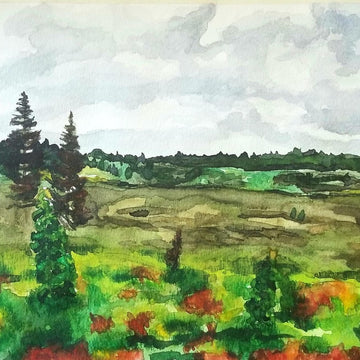When you first start painting with watercolours, you might think you might have to use it exclusively to achieve the best results.
In this article, you'll learn that not only can you use more than paints, but the list of other media you can mix with it is almost endless.
You can beautifully add in coloured pencils on top of watercolour, then use inks, markers, gouache, and so much more.
Experimenting and figuring out what works with watercolour to make it a unique painting is a journey on its own, and it can be so much fun!
The Journey
Black and white ink are usually used to add in the details, with the occasional marker thrown in the mix. So, if you haven't tried other media on a watercolour piece before, it might be time to push some boundaries!
Ready to go on this journey with me? Read along to follow the map I used!
Suggested materials: gouache, acrylic, watercolour pens/markers or pencils, water-based or soluble markers, coloured pencils, ink, pens, pencils, oil pastels, pastels, crayons, charcoal, or anything else you find!
Also, keep in mind the quality of the paper. You’ll want a thick and toothy watercolour sheet (our 100% cotton sketchbooks are perfect for this).
Adding layers could lead to paper pills. Even good paper will pill if, for example, you don’t wait to add marker between watercolour washes or overwork an area.

The Watercolour Park
Begin by collecting interesting supplies and some of the aforementioned tools, plus some nice, reliable watercolour paper. You’ll also need your watercolour palette, brushes, water bucket, etc.
Tape down your paper and sketch out a scene in pencil. Proceed to coat with watercolours as you normally do.
Keep in mind future spots where you’d like to bring in other mediums.
Leave some areas out or paint fewer layers, so the interaction with, for example, coloured pencils wouldn’t be lost in shadows of colour.
Depending on your area of focus, keep your subject or foreground detailed and the preceding surroundings or background simple.
Once dry, you can introduce straight watercolour or gouache via wet on dry for texture.
The Carpool
Now comes the fun experimental part! Your painting is now dry so you can invite different supplies to the party. If the application of mixed materials is thin enough, you should be able to see the relationship between them and the watercolour underneath.
In the painting, there are four types of water-soluble markers laid down to start a new layer.
All four markers offer great control. Two are brushes filled with watercolour pigment. One has a colour reservoir and loaded brush while the other has a marker-type cartridge.
The loaded brush pigment is free-flowing saturated colour to blend or leave as is. The watercolour pen has felt tips but is still saturated, again for blending or not.
The other two markers don't have watercolour proper, but their pigment can be applied the same way and blended out.
Remember, this stage could be another opportunity for your paper to pill. If your wait time between wet layers isn’t long enough, the felt brush will tear it up.

The Main Attraction: Texture Station
Next up: watercolour pencils! They are less harsh than markers and offer subtle gradations. Depending on the colour, you may have to apply more pressure to the paper.
This should take away any hesitation about trying something new. You have the option to be selective about brushing water onto this layer for control. You may even see a nice leftover texture from the pencil!
Before jumping into a regular coloured pencil, I wanted to ink details and basic shapes.
Sometimes pens, depending on the ink, will skip across waxy or loose (coloured pencil, oil pastels, charcoal) textures and not show.
Tree forms, branches, trunks, and shaded a few areas in the background for depth and definition were then added.
Bonus tip: before laying down textured materials, determine a pathway for you to work - left to right or top to bottom for example. Otherwise, you might end up with a messy hand or an unintentional blending.
Coloured pencils are an easy method to add colours to an area without worrying about losing the process under it. This may also be a study on blending.
You aren’t solely relying on them for all the colour blending because of the watercolour below. They are very versatile - they can either be subtle or work hard for you.
You can also utilise them for colour studies and texture rather than just shape.
Oil pastels are another medium if you want to try blending effortlessly over watercolour. They blend easier than coloured pencils but are very vibrant. You can dab them for a stronger impression, rather than blended in.
In the painting, the aim was to show shrubbery, so I dabbed the oil pastels around and over the thin branches sticking out and loosely blended the pastels for a collage of bushes.
The more dabs and texture meant a stronger impression of the plants.

Finally, the charcoal pencils are the dustiest material on the list, so it's probably a good idea to save them for last. You can use them for highlights, but they like to be smoothly blended out, too.
Final Road Trip Notes
Don’t forget to spray a light varnish over your painting or your hard work will end up smeared. Keep experimenting with new and different tools; your instincts may surprise you on what you discover next!
Have you found any cool mediums to combine with watercolour?
We’d love to hear your recommendations. Or have you tried to before? Let us know how it went!


